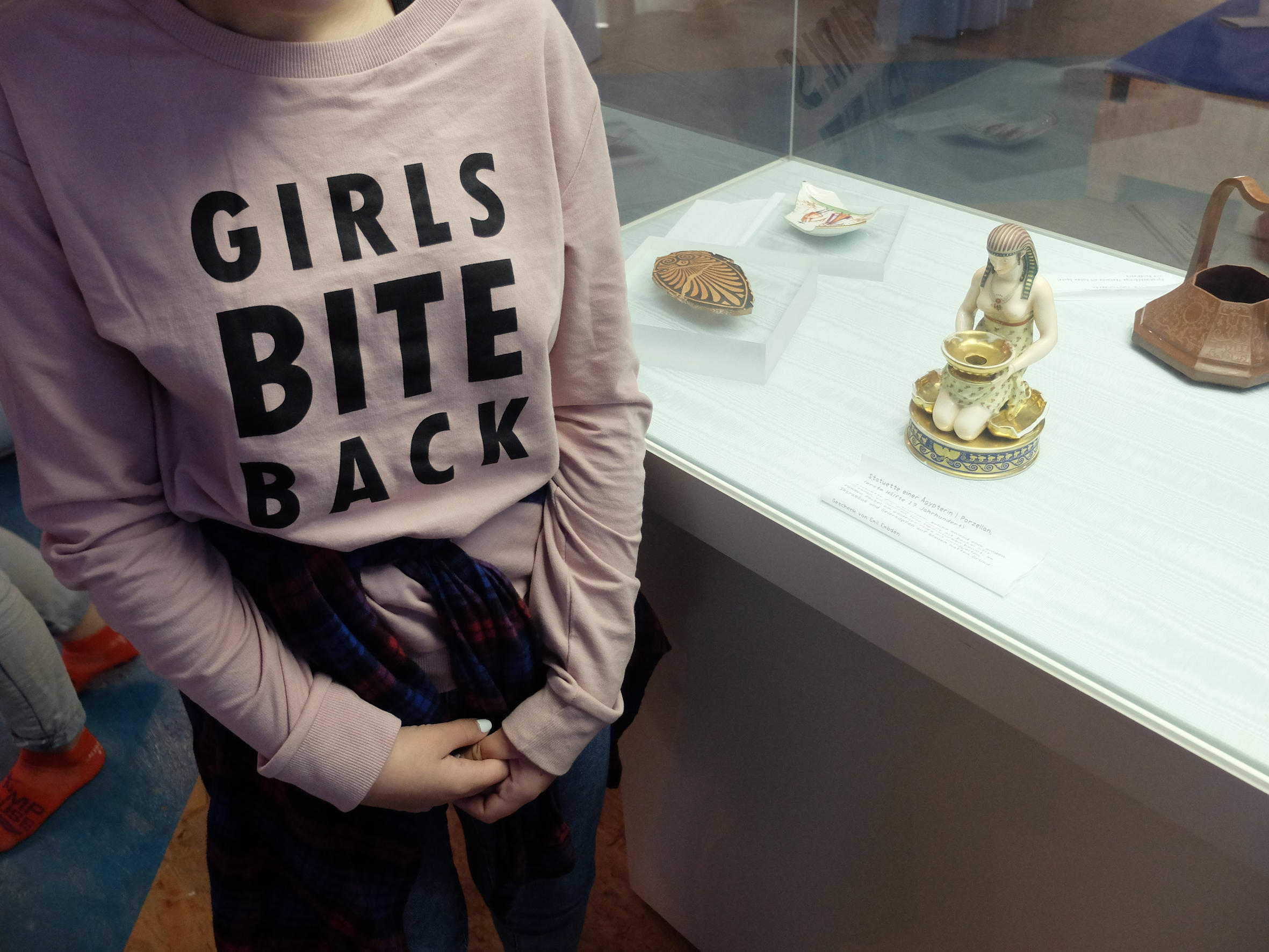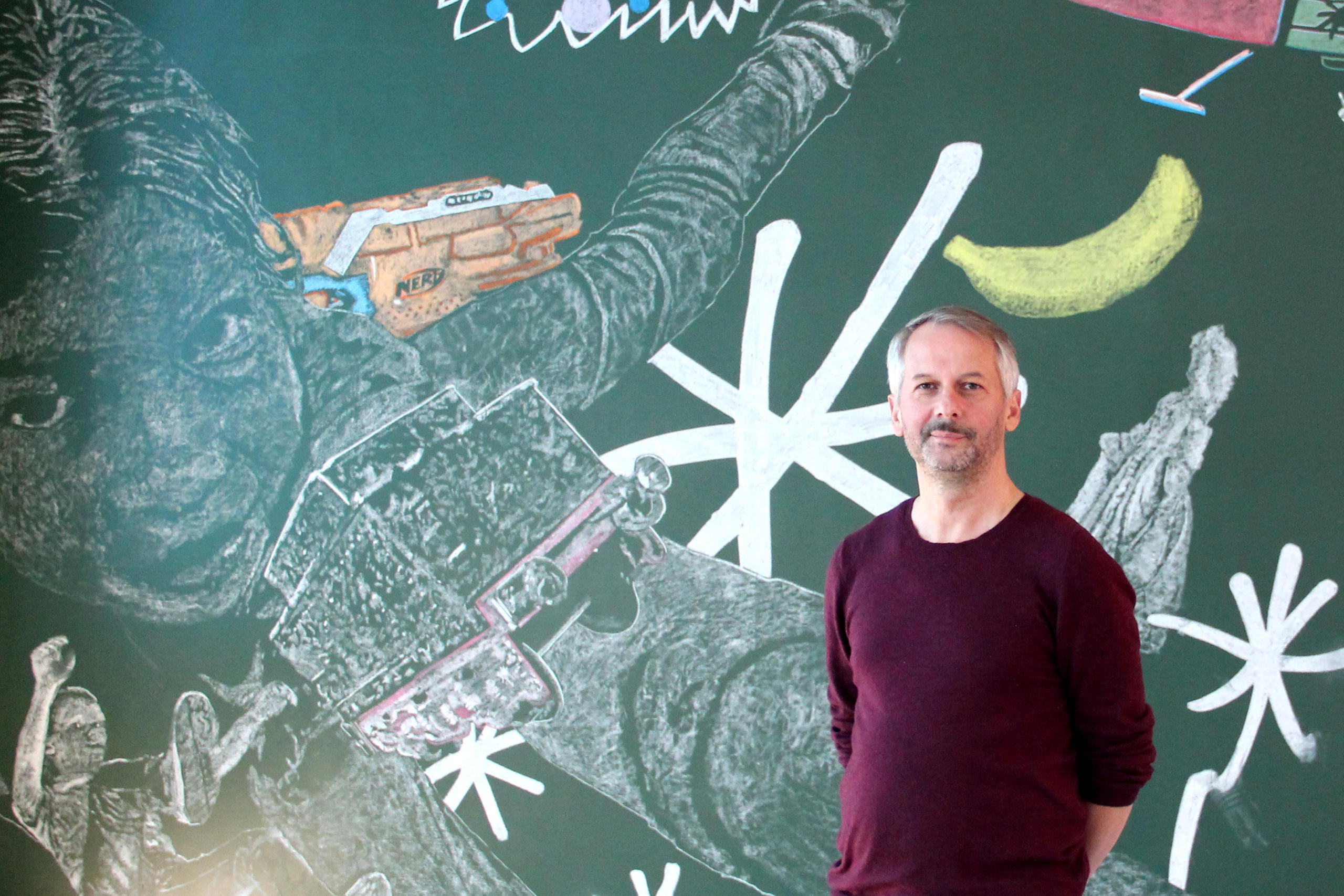Experiments made in Zurich defy museum conventions

An eclectic selection of objects is on show on the ground floor of Hamburg’s Museum of Applied Arts (Museum für Kunst und Gewerbe - MKG).
Among the discoveries in the exhibition “Mobile WorldsExternal link” are a Congolese figurine of a white missionary; a plaster model of an eighth-century Syrian sculpture of a goddess; a pile of rubber tyres; a beautifully painted pair of Indian doors; a football signed by Pele; and a collection of tsubas, Samurai sword mountings. Contemporary art rubs shoulders with ancient artefacts. Asian porcelain is juxtaposed with modern European fashion, Kurdish activists, and images of African hair art.
Roger Buergel, the guest curator of the show (together with Sophia Prinz), likes to mix things up. “Mobile Worlds” is the result of curatorial experiments Buergel and Prinz have been carrying out in the Johann Jacobs Museum in Zurich since Buergel took the challenge, in 2013, to revamp the old “Coffee Museum” set up originally in the mid-1980s by the coffee-and-cocoa trade mogul Klaus Jacobs.

The exhibition in Hamburg explicitly takes aim at the traditional compartmentalisation and categorisation of western encyclopaedic museums – institutions like the Metropolitan in New York, the Victoria & Albert in London, or, indeed, the Hamburg Museum of Applied Arts, which is carefully sub-sectioned into departments with titles like “Musical Instruments,” “Antiquity,” or “Baroque to Classicism.”
Buergel is interested in museum artefacts that don’t fit neatly into these categories. Instead of traditional categorisation by era or origin – and to avoid the dominant Eurocentric narrative of western encyclopaedic museums – Buergel has instead designated specific themes that thread through the exhibition, such as Hair, Meiji and Later, Trade with China, and Suez Canal.
“Sticking to geopolitical identities is a mistake,” he says. “This compartmentalization doesn’t work. There are always objects that contradict this order. These things often remain in storage.”
Against the 19th century model
The misfits from the depot often reveal more about history than the objects on display in museums, because they show how interconnected our world has been for centuries, says Buergel, who was the artistic director of the quinquennial German contemporary art show Documenta in 2007.
A telling example in “Mobile Worlds” is a sixteenth-century, Chinese-made, Arabian-style porcelain bottle, complete with pseudo-Arabian script and produced for the Islamic market. This is exhibited alongside a seventeenth-century Persian plate adorned with a fake Chinese script – produced for the Chinese market. These two objects shown together illustrate much more than the history of porcelain making; they also reveal the marketing strategies and trade routes of previous civilisations.
The modern western idea of a museum is a construct of the nineteenth century, a period of burgeoning nationalism and colonial expansionism. Museums currently face enormous challenges to stay relevant in an era of increased globalisation and immigration. In Germany – which has accepted record numbers of immigrants in recent years – a debate over the provenance of artefacts acquired from colonies seized headlines last year in connection with the opening, planned for 2019, of the new Humboldt Forum, which will display Berlin’s non-European collections in a reconstruction of the royal palace.
Culture Minister Monika Grütters said that confronting the colonial past has been “a blind spot” in Germany and has made it a priority of her new term in office. She is encouraging museums to cooperate with the communities of origin to find out more about their artefacts and is providing funding for provenance research.
So “Mobile Worlds”, a cooperation with the Erich-Kästner-Schule in Hamburg and two German universities, is a topical – and radical – challenge to the traditional structure of museums and the choices curators make. “I think that a lot of what is boring and conventional in museums is because curators think the public can’t understand anything more complex, that we can’t expect that much of people, but I think that’s not true,” Buergel says. “A bit of madness makes a lot more possible.”
Poetic wildness
How does this “madness”, or as Buergel also calls it, this “poetic wildness” affect the museum-goer? It requires a receptive frame of mind, an openness to serendipity. You can’t rush around looking for individual artworks you want to see. You are forced to browse slowly, and it takes time to grasp the connections between exhibits. “Some feel a bit threatened because the usual orientation of a museum visit is missing,” Buergel says. “But there are people who like this new breathing space, the unexpected constellations, and who like to do some work.”
Patience can be richly rewarded. A fascinating discovery is a set of kimonos made in Japan before and during World War II, featuring motifs of fighter planes and swastikas. Buergel explains that as Japan modernised at breath-taking pace in the late nineteenth and early twentieth centuries, the traditional dress became increasingly journalistic, reflecting major events. “In Japan, these are completely taboo,” he says. “You never get to see them. We borrowed them from a private collector in Sapporo, a textile historian.”
In its quest to break down silos, “Mobile Worlds” transverses centuries as well as regions. The plaster cast of the eighth century Syrian goddess from Tell Halaf is juxtaposed with screened images of contemporary female freedom fighters from Rojava, or the Democratic Federation of Northern Syria. Buergel says this reflects our society better than chronology and believes that organising exhibits by era is also artificial.
“Temporality is not linear,” he says. “Things from different times can co-exist. In Bangalore, the Infosys campus, the Indian Microsoft, is somehow 23rd century with its own nuclear power station, surrounded by a huge wall guarded by a private army. Just next to it you can find a poor mother washing clothes by hand, as though it was 500 years ago – all within 10 metres.”
Buergel is still working on his exhibition and likes the idea of presenting it to the public unfinished. “People like looking at building sites,” he says. At the moment, he is experimenting with text and asking what museum-goers need to know about the exhibits.
“Mobile Worlds” is in itself an experiment – but one that Buergel believes is successful. “It’s a bit like cooking, you don’t know how it will turn out,” he says. “There are a lot of collaborators and things have to come together at the last minute. It worked here.”
Mobile Worlds, or the Museum of our Transcultural Present
Until Oct. 14th 2018
Museum für Kunst und Gewerbe (MKG), Hamburg (GER)
Steintorplatz
20099 Hamburg
www.mobile-welten.org/External link

In compliance with the JTI standards
More: SWI swissinfo.ch certified by the Journalism Trust Initiative
You can find an overview of ongoing debates with our journalists here. Please join us!
If you want to start a conversation about a topic raised in this article or want to report factual errors, email us at english@swissinfo.ch.